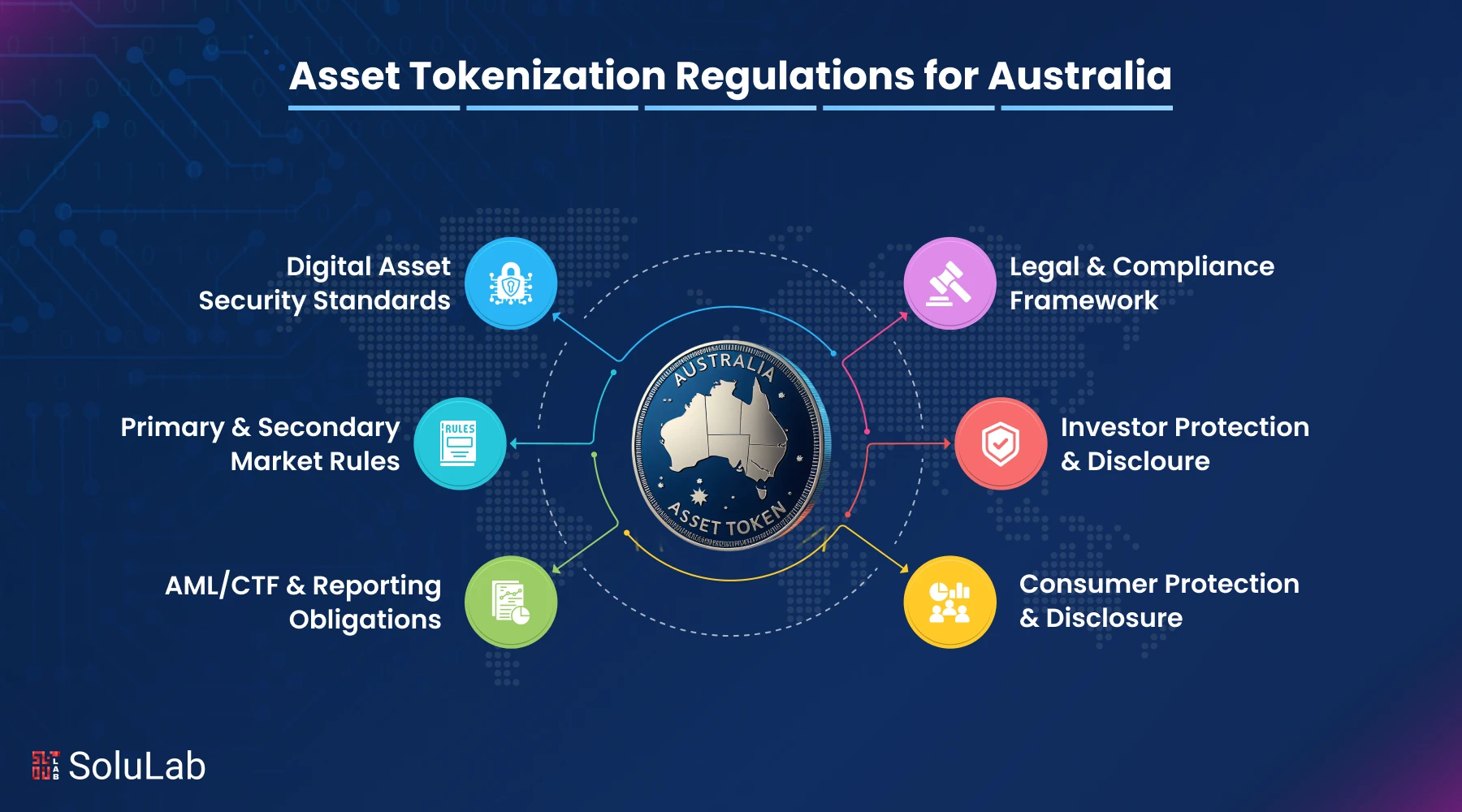
As of 2025, Australia aims to be a global hub for RWA tokenization, with banks, fintechs, and blockchain firms already running live pilots. Projects like Acacia and Project Guardian show the country’s commitment to linking digital tokens to real economic assets through interoperable, multi-chain settlement systems.
What makes this move important is that it doesn’t reinvent the wheel; it adapts existing financial services laws and aligns them with token-based technologies. From custodial responsibilities to transaction settlement, the new framework focuses on “same activity, same risk, same regulation.” It gives businesses a roadmap to operate legally while building investor confidence in tokenized systems.
In this blog, we’ll unpack how asset tokenization regulations in Australia are reshaping the financial ecosystem. Also, what businesses need to know about compliance, and why 2025 could be the turning point for companies entering this rapidly growing sector.
What Businesses Need to Know About Australia’s Digital Asset Regulation?
Australia is moving from uncertainty to a global structure. The recent draft reforms take an activity-based approach instead of inventing a single legal definition of “digital asset.” Practical effect: familiar financial rules apply where an activity looks like a financial service, and targeted carve-outs exist where blockchain infrastructure behaves like infrastructure.
Key thresholds and licensing triggers
- AFSL trigger for Digital Asset Platforms (DAPs) proposed threshold of AUD 5,000 per customer and AUD 10 million in transactions over a rolling 12-month period
- Earlier proposals: thresholds previously floated were AUD 1,500 per customer or AUD 5 million in aggregate holdings; the new numbers give more room for smaller operations.
- Notification requirement: entities relying on exemptions still must notify ASIC, so regulatory visibility remains.
Practical takeaways for businesses
- If your platform custody exceeds those thresholds, plan for AFSL processes and governance controls now.
- If you rely on exemptions (e.g., coffee-shop style incidental crypto acceptance), document how your activity is incidental and set up simple compliance checks.
- Intermediated services (staking, custodian activity) will attract scrutiny. Design flows that preserve client redemption rights and explicit lawful instruction paths.
Tokenization in Australia: From Real Estate to Private Credit and Carbon Assets

Asset tokenization in Australia already spans multiple classes. Each class carries distinct regulatory and commercial tradeoffs; know these before you build.
Real estate tokenization is the compliance-heavy lift
Property wrapped into tokens representing economic rights or rental income. In Australia, real estate is one of the major parts that has major exchange usage. Let’s see how tokenization is shifting this.
- Key legal points: property law continues to govern title; real estate tokenization needs a legal wrapper (e.g., company or trust).
- Tax signals: capital gains tax, income tax on rental yield, potential GST and state transfer duties. Each project requires tailored tax structuring.
- Commercial opportunity: fractional ownership unlocks retail and cross-border demand for large assets.
Private credit and institutional adoption
Private credit is already leading in scale; tokenized lending and invoice financing are gaining traction.
- Benefit: faster settlement, improved transparency, programmable repayments.
- Expectation: institutional buyers demand robust AML/KYC, custody segregation, and audited smart contract logic.
Carbon credits, commodities, and niche assets
Carbon credits are growing rapidly not only in Australia but also globally. If you want to grow with the ecosystem, then you must adopt carbon credit tokenization to gain favor in Australia’s tokenization laws.
- Carbon credits: strong use case for provenance, expiry rules, and traceable retirements.
- Commodities and inventory: IoT or Oracle integration required to link physical quantity to tokens.
- Business design: include automated compliance, clear redemption and transfer mechanics, and insured custody where possible
Navigating ASIC, AML/CTF, and MIS Rules
Regulatory compliance sits at the core of successful tokenization. Know the main regulatory levers and build accordingly.
ASIC and licensing posture
ASIC’s view focuses on “same activity, same risk, same regulation.” If your platform behaves like a custodial or managed service, expect AFSL obligations.
- Design controls: custody separation, operational resilience, voting policy for governance tokens, and regular breach reporting.
AML/CTF and onboarding
- AML/CTF obligations apply to token platforms in scope. KYC, transaction monitoring, and suspicious matter reporting must be baked into onboarding and transaction flows.
- Practical step: integrate risk-based identity verification and automated transaction screening from day one.
Managed Investment Scheme (MIS) risk
- Token fractionalization often creates MIS exposure. The draft rules carve out DAPs/TCPs from MIS classification only if clients retain redemption rights and operators act strictly on lawful instructions.
- Design implication: avoid product structures where the operator materially negotiates or determines rights; otherwise, MIS compliance and disclosure become mandatory.
The Future of Tokenization in Australia
Momentum exists. Regulators offering sandboxes, banks piloting settlement rails, and cross-border initiatives gaining traction. For businesses, preparation beats reaction.
- Continued industry engagement with Treasury and ASIC through consultations.
- Sandbox testing is recommended before full licensing to de-risk product design.
- Expect interoperability priorities: linkage to national rails (e.g., PayTo), stablecoin rails for settlement, and cross-chain protocols.
- Short-term playbook: finalize legal wrappers, implement robust AML/KYC, build custody and recovery controls, and design investor protections (redemption, disclosure).
- Medium-term advantage: first movers in niche verticals (private credit, carbon, high-value real estate) can capture liquidity ahead of broader standardization.
Conclusion
Australia is entering a new era of trust and transparency through digital asset regulation and structured asset tokenization frameworks. With clear compliance standards, businesses can now raise funds faster, reduce risk, and expand investor access without legal uncertainty. The combination of strong laws and advanced blockchain platforms is setting the stage for long-term growth in real-world asset tokenization in Australia.
If you’re planning to build a compliant, future-ready platform, SoluLab, a trusted asset tokenization development company, can help you navigate every step of the journey. Our white label tokenization solutions enable businesses to launch branded platforms quickly.
Contact us today for more information and how we work.
FAQs
1. What are the key asset tokenization regulations in Australia for 2025?
The 2025 framework introduces clear licensing for Digital Asset Platforms (DAPs) and Tokenized Custody Platforms (TCPs), ensuring compliance under Australia’s financial laws.
2. How does Australia’s asset tokenization compliance help businesses?
It reduces regulatory risk, improves investor confidence, and ensures that platforms offering RWA tokenization or custody services meet ASIC’s governance standards.
3. Which industries benefit most from Real-World Asset Tokenization in Australia?
Real estate, private credit, and carbon credits lead adoption, supported by asset tokenization services in Australia offering secure, compliant digital investment platforms.
4. Why should I choose SoluLab as my asset tokenization development company?
SoluLab, a leading asset tokenization company in Australia, builds compliant, scalable, and white-label tokenization solutions aligned with ASIC and AML/CTF frameworks.
5. Can tokenized assets in Australia connect to global financial systems?
Yes, new interoperability standards allow integration with PayTo, stablecoins, and cross-chain settlement, expanding access to international liquidity pools.






